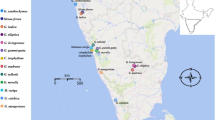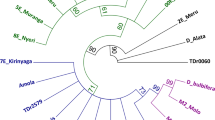Abstract
Ceylon oak (Schleichera oleosa (Lour.) Oken), belonging to Sapindaceae family, is a widely used plant for its medicinal properties. Currently, few studies have been conducted on Ceylon oak’s genetic background and its relationship with other closely related plants in Thailand. Therefore, this study focused on the analysis of nucleotide sequences to understand the genetic diversity and relationship of Ceylon oak with longan and lychee. The nucleotide sequencing of six loci, namely ITS2, matK, rbcL, trnH-psbA, trnL-i and trnL-trnF was analyzed in five Ceylon oak samples collected from various locations in Thailand and then were additionally aligned with nucleotide sequences of 36 longan samples and 2 lychee samples (7 species) (GenBank accession nos. KY174077–KY174314). The sequencing results were then used to construct a phylogenetic tree using the maximum likelihood criteria. Multiple sequence alignment revealed the highest InDel polymorphism of trnH-psbA fragment which can be developed as a DNA molecular marker in the identification of Ceylon oak. Interestingly, the K2P pairwise distance analysis revealed a high degree of genetic variation between Ceylon oak, longan and lychee samples and the combination of either matK and trnH-psbA or matK and ITS2 provided the most potential candidate DNA barcoding region for discrimination of Ceylon oak from longan and lychee. The phylogenetic tree showed that Ceylon oak is completely different from longan and lychee. This is the first report of phylogenetic information among Ceylon oak, longan and lychee in Thailand which might be used to assist Ceylon oak conservation and breeding program in the future.






Similar content being viewed by others
REFERENCES
Amundsen, K. and Warnke, S., Agrostis species relationships based on trnL-trnF and atpI-atpH intergenic spacer regions, HortScience, 2012, vol. 47, pp. 18–24.
Balamurugan, S., Vijayakumar, S., Prabhu, S., et al., Traditional plants used for the treatment of gynaecological disorders in Vedaranyam taluk, South India – An ethnomedicinal survey, J. Tradit. Complementary Med., 2017, vol. 8, pp. 308–323.
Bhatia, H., Kaur, J., Nandi, S., Gurnani, et al., A review on Schleichera oleosa: Pharmacological and environmental aspects, J. Pharm. Res., 2013, vol. 6, pp. 224–229.
CBOL Plant Working Group. A DNA barcode for land plants, Proc. Natl. Acad. Sci. U. S. A., 2009, vol. 106, pp. 12794–12797.
Chen, S., Yao, H., Han, J., et al., Validation of the ITS2 region as a novel DNA barcode for identifying medicinal plant species, PLoS One, 2010, vol. 5, p. e8613.
DeSalle, R. and Goldstein, P., Review and interpretation of trends in DNA barcoding, Front. Ecol. Evol., 2019, vol. 7.
Fu, Y.M., Jiang, W.M., and Fu, C.X., Identification of species within Tetrastigma (Miq.) Planch. (Vitaceae) based on DNA barcoding techniques, J. Syst. Evol., 2011, vol. 49, pp. 237–245.
Ghorbani, A., Saeedi, Y., and de Boer, H.J., Unidentifiable by morphology: DNA barcoding of plant material in local markets in Iran, PLoS One, 2017, vol. 12, p. e0175722.
Ghosh, P., Chakraborty, P., Mandal, A., et al., Triterpenoids from Schleichera oleosa of Darjeeling foothills and their antimicrobial activity, Indian J. Pharm. Sci., 2011, vol. 73, pp. 231–233.
Guindon, S., Dufayard, J.F., Lefort, V., et al., New algorithms and methods to estimate maximum-likelihood phylogenies: assessing the performance of PhyML 3.0, Syst. Biol., 2010, vol. 59, pp. 307–321.
Hall, T.A., A User-friendly biological sequence alignment editor and analysis program for Windows 95/98/NT, Nucleic Acids Symp. Ser., 1999, vol. 41, pp. 95–98.
Han, S., Sebastin, R., Wang, X., et al., Identification of vicia species native to South Korea using molecular and morphological characteristics, Front. Plant Sci., 2021, vol. 12, p. 608559.
Hsu, W.K., Lee, S.C., and Lu, P.L., A useful technical application of the identification of nucleotide sequence polymorphisms and gene resources for Cinnamomum osmophloeum Kaneh. (Lauraceae), Forests, 2019, vol. 10, p. 306.
Kimura, M., A simple method for estimating evolutionary rates of base substitutions through comparative studies of nucleotide sequences, J. Mol. Evol., 1980, vol. 16, pp. 111–120.
Kool, A., de Boer, H.J., Krüger, A., et al., Molecular identification of commercialized medicinal plants in southern Morocco, PLoS One, 2012, vol. 7, p. e39459.
Kress, W.J., Plant DNA barcodes: Applications today and in the future: Plant DNA barcode applications, J. Syst. Evol., 2017, vol. 55, pp. 291–307.
Kress, W.J. and Erickson, D.L., A two-locus global DNA barcode for land plants: the coding rbcL gene complements the non-coding trnH-psbA spacer region, PLoS One, 2007, vol. 2, p. e508.
Kress, W.J., Wurdack, K.J., Zimmer, E.A., et al., Use of DNA barcodes to identify flowering plants, Proc. Natl. Acad. Sci. U. S. A., 2005, vol. 102, pp. 8369–8374.
Kumar, S., Stecher, G., Li, M., et al., MEGA X: Molecular Evolutionary Genetics Analysis across Computing Platforms, Mol. Biol. Evol., 2018, vol. 35, pp. 1547–1549.
Lithanatudom, S.K., Chaowasku, T., Nantarat, N., et al., A first phylogeny of the genus Dimocarpus and suggestions for revision of some taxa based on molecular and morphological evidence, Sci. Rep., 2017, vol. 7, no. 1, p. 6716. https://doi.org/10.1038/s41598-017-07045-7
Loera-Sánchez, M., Studer, B., and Kölliker, R., DNA barcode trnH-psbA is a promising candidate for efficient identification of forage legumes and grasses, BMC Res. Notes, 2020, vol. 13, p. 35.
Mateikovich, A.P., Punina, E.O., Kopylov-Guskov, Y.O., et al., ITS1–5.8S rDNA–ITS2 and trnL-trnF sequences as markers for the study of species diversity of Altai feather grasses, Russ. J. Genet., 2020, vol. 56, pp. 417–428.
Newmaster, S.G., Grguric, M., Shanmughanandhan, D., et al., DNA barcoding detects contamination and substitution in North American herbal products, BMC Med., 2013, vol. 11, p. 222.
Palanuvej, C. and Vipunngeun, N., Fatty acid constituents of Schleichera oleosa (Lour) Oken seed oil, J. Health Res., 2008, vol. 22, p. 203.
Parveen, I., Gafner, S., Techen, N., et al., DNA barcoding for the identification of botanicals in herbal medicine and dietary supplements: strengths and limitations, Planta Med., 2016, vol. 82, pp. 1225–1235.
Pettit, G.R., Numata, A., Cragg, G.M., et al., Isolation and structures of schleicherastatins 1–7 and schleicheols 1 and 2 from the teak forest medicinal tree Schleichera oleosa, J. Nat. Prod., 2000, vol. 63, pp. 72–78.
Purushothaman, N., Newmaster, S.G., Ragupathy, S., et al., A tiered barcode authentication tool to differentiate medicinal Cassia species in India, GMR, Genet. Mol. Res., 2014, vol. 13, pp. 2959–2968.
Sgamma, T., Lockie-Williams, C., Kreuzer, M., et al., DNA barcoding for industrial quality assurance, Planta Med., 2017, vol. 83, pp. 1117–1129.
Silprasit, K. and Thummajitsakul, S., Short ITS DNA barcode effectively distinguishes the medicinal plants Cyclea barbata, Songklanakarin J. Sci. Technol., 2020, vol. 42, pp. 1197–1206.
Stecher, G., Tamura, K., and Kumar, S., Molecular Evolutionary Genetics Analysis (MEGA) for macOS, Mol. Biol. Evol., 2020, vol. 37, pp. 1237–1239.
Sun, W., Li, J.J., Xiong, C., et al., The potential power of Bar-HRM technology in herbal medicine identification, Front. Plant Sci., 2016, vol. 7, p. 367.
Taberlet, P., Gielly, L., and Pautou, G., Universal primers for amplification of three non-coding regions of chloroplast DNA, Plant Mol. Biol., 1991, vol. 17, pp. 1105–1109.
Thind, T.S., Rampal, G., Agrawal, S.K., et al., Diminution of free radical induced DNA damage by extracts/fractions from bark of Schleichera oleosa (Lour.) Oken, Drug Chem. Toxicol., 2010, vol. 33, pp. 329–336.
Vashishtha, A., Jehan, T., and Sharma, K., Molecular characterization and genetic diversity of Schleichera oleosa (Lour.) Oken: Major Host Tree for Lac Cultivation, Natl. Acad. Sci. Lett., 2013, vol. 36, pp. 429–435.
Yu, J., Wu, X., and Liu, C., Progress in the use of DNA barcodes in the identification and classification of medicinal plants, Ecotoxicol. Environ. Saf., 2021, vol. 208, p. 111691.
ACKNOWLEDGMENTS
This research was funded by Teaching Assistant and Research Assistant Scholarships for the Academic Year 2020, Chiang Mai University (NJ) and Thailand Science Research and Innovation (TSRI) under Grant no. DBG6180017 (SKL).
Author information
Authors and Affiliations
Contributions
AUTHOR CONTRIBUTIONS
NJ and SKL performed research. SKL and PL designed the research study. NJ and SKL collected and provided samples. NJ, PL and SKL analyzed the data. NJ, PL and SKL wrote the manuscript. All authors approved the final version of this manuscript.
SUPPLEMENTARY INFORMATION
The online version contains supplementary material available at https://doi.org10.3103/S0095452723040060.
Corresponding author
Ethics declarations
The authors declare that they have no conflicts of interest. This article does not contain any studies involving animals or human participants performed by any of the authors.
About this article
Cite this article
Jaitan, N., Lithanatudom, P. & Lithanatudom, S.K. DNA Barcoding and Phylogenetic Analysis of Ceylon Oak with Other Fruit Plants in Sapindaceae Family. Cytol. Genet. 57, 356–366 (2023). https://doi.org/10.3103/S0095452723040060
Received:
Revised:
Accepted:
Published:
Issue Date:
DOI: https://doi.org/10.3103/S0095452723040060




